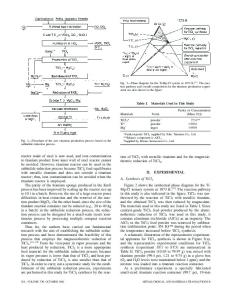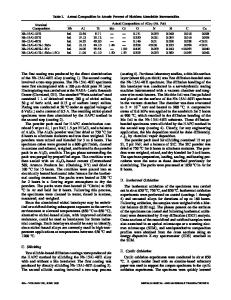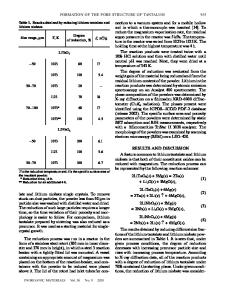A fundamental study on the preparation of niobium aluminide powders by calciothermic reduction
- PDF / 1,271,328 Bytes
- 7 Pages / 603.28 x 783.28 pts Page_size
- 97 Downloads / 278 Views
I.
INTRODUCTION
IN recent years, niobium, which has the lowest density among refractory metals, has been a subject of research interests, due to the increasing demand for highperformance alloys for advanced high4emperature applications in aircraft and spacecraft technology311 The problem of oxidation resistance of the alloys is the major obstacle to application. Among the many niobium alloys, niobium aluminides which demonstrate some degree of inherent oxidation resistance seem to be one of the most promising materials. NbAI3 is an interesting aluminide for high-temperature use as it has a high melting point of about 1950 K, promising oxidation resistance t2] and low density (4.54 g/cm3). As shown in Figure !, Nb3A1 and Nb2A1, which both demonstrate a range in stoichiometry,t3-61 can be produced by furnace-melting with some excess charge of aluminum in the feed material and subsequent annealing. Production of NbA13 single phase by using the method of conventional melting seems to be difficult, because this aluminide has a very narrow composition range (line compound) and the difference in the vapor pressure of niobium and aluminum is rather large. Fine NbA13 powder of high purity for powder metallurgy use is required not only because of difficulties in melting the alloy but also because of difficulties in fabrication due to poor ductility. The desired NbAI3 powder can also find use as a matrix material in composite materials. I7~ Our previous studies t8.91 have shown that coreduction of oxide mixtures by metallic calcium can directly produce fine titanium aluminide powders suitable for powder metallurgy at relatively low temperatures. The stoichiometry of the titanium aluminides could also be T.H. OKABE, Ph.D. Candidate, K. FUJIWARA, Graduate Student, T. OISHI, Associate Professor, and K. ONO, Professor, are with the Department of Metallurgy, Kyoto University, 606 Kyoto, Japan. Manuscript submitted October 24, 1991. METALLURGICAL TRANSACTIONS B
controlled readily using Ca-AI alloys, and fine powders containing low levels of oxygen (0. t to 0.25 wt pc0 could be produced directly from their oxides. These processes are characterized by the use of readily available feed oxides. However, some thermodynamic data such as aluminum activity of the alloys is required for stoichiometric control. The purpose of this work is to establish experimentally practical processes for preparation of fine niobiumaluminum alloy powders, especially NbAI3 single phase, by calciothermic reduction around 1273 K. Review of the literature shows that calcium can affect reduction of Nb~Os and A1203t1~ and that niobium and calcium are mutually insoluble lllj while calcium and aluminum may form a liquid alloy or CaA12 compound at the reduction temperature, as shown in Figure 2.1~21 When a mixture of Nb2Os, calcium, and aluminum is reacted at 1273 K, calcium, which has the strongest aff'mity for oxygen, will react with the oxide to form CaO, provided the activity of calcium in the system is sufficiently high. Suzuki e t al. t91 studied the Ca-A1
Data Loading...











